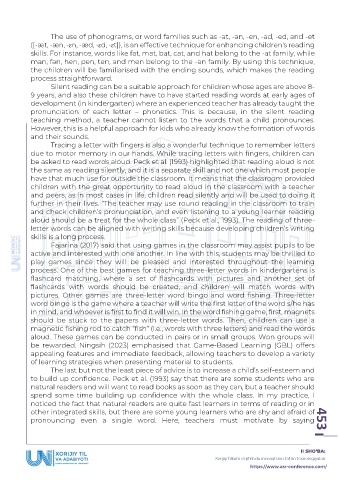Page 455 - Konferensiya to'plami - 1 (ASR)
P. 455
The use of phonograms, or word families such as -at, -an, -en, -ad, -ed, and -et
([-æt, -æn, -ɛn, -æd, -ɛd, -ɛt]), is an effective technique for enhancing children's reading
skills. For instance, words like fat, mat, bat, cat, and hat belong to the -at family, while
man, fan, hen, pen, ten, and men belong to the -an family. By using this technique,
the children will be familiarised with the ending sounds, which makes the reading
process straightforward.
Silent reading can be a suitable approach for children whose ages are above 8-
9 years, and also these children have to have started reading words at early ages of
development (in kindergarten) where an experienced teacher has already taught the
pronunciation of each letter – phonetics. This is because, in the silent reading
teaching method, a teacher cannot listen to the words that a child pronounces.
However, this is a helpful approach for kids who already know the formation of words
and their sounds.
Tracing a letter with fingers is also a wonderful technique to remember letters
due to motor memory in our hands. While tracing letters with fingers, children can
be asked to read words aloud. Peck et al. (1993) highlighted that reading aloud is not
the same as reading silently, and it is a separate skill and not one which most people
have that much use for outside the classroom. It means that the classroom provided
children with the great opportunity to read aloud in the classroom with a teacher
and peers, as in most cases in life, children read silently and will be used to doing it
further in their lives. “The teacher may use round reading in the classroom to train
and check children’s pronunciation, and even listening to a young learner reading
aloud should be a treat for the whole class” (Peck et al., 1993). The reading of three-
letter words can be aligned with writing skills because developing children’s writing
skills is a long process.
Fajarina (2017) said that using games in the classroom may assist pupils to be
active and interested with one another. In line with this, students may be thrilled to
play games since they will be pleased and interested throughout the learning
process. One of the best games for teaching three-letter words in kindergartens is
flashcard matching, where a set of flashcards with pictures and another set of
flashcards with words should be created, and children will match words with
pictures. Other games are three-letter word bingo and word fishing. Three-letter
word bingo is the game where a teacher will write the first letter of the word s/he has
in mind, and whoever is first to find it will win. In the word fishing game, first, magnets
should be stuck to the papers with three-letter words. Then, children can use a
magnetic fishing rod to catch “fish” (i.e., words with three letters) and read the words
aloud. These games can be conducted in pairs or in small groups. Won groups will
be rewarded. Ningsih (2023) emphasised that Game-Based Learning (GBL) offers
appealing features and immediate feedback, allowing teachers to develop a variety
of learning strategies when presenting material to students.
The last but not the least piece of advice is to increase a child’s self-esteem and
to build up confidence. Peck et al. (1993) say that there are some students who are
natural readers and will want to read books as soon as they can, but a teacher should
spend some time building up confidence with the whole class. In my practice, I
noticed the fact that natural readers are quite fast learners in terms of reading or in
other integrated skills, but there are some young learners who are shy and afraid of
pronouncing even a single word. Here, teachers must motivate by saying 453
II SHO‘BA:
Xorijiy tillarni o‘qitishda innovatsion taʼlim texnologiyalari
https://www.asr-conference.com/

